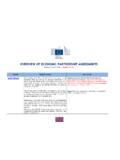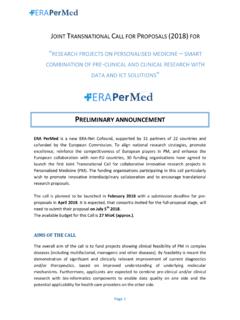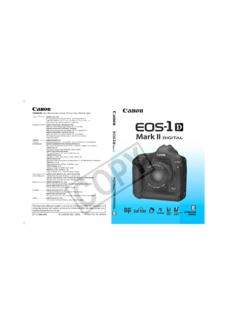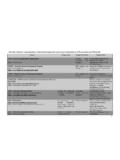Transcription of Comparative case study of the construction and …
1 International HISER Conference on Advances in Recycling and Management of construction and Demolition Waste 21-23 June 2017, Delft University of Technology, Delft, The Netherlands Comparative case study of the construction and demolition waste practical treatment induced by different legislations in France and Belgium (Wallonia and Flanders)Mignon and Br quel 1 Centre Terre et Pierre (CTP), Chauss e d Antoing 55, 7500 Tournai, Phone (+32) 69 88 42 51; email: A Comparative case study of the current legislation and state of the art of practical procedures and methodologies used for the treatment of construction and Demolition Waste (CDW) between France and Belgium (Flanders and Wallonia) will be presented in the framework of the project VALDEM (Interreg Va France-Wallonie-Vlaanderen Convention n ).
2 The authors exhibit the differences in practice for the demolition companies induced by different policies at regional or national level. Typical examples are given concerning the various mandatory phases of a demolition work, their organization, with a link to the resulting quality of CDW (number and type of waste stream collected, purity of each stream, and identification of the undesired material). Emphasis will be put on the technical feasibility versus the legal feasibility for each region. Existing valorization routes are also mentioned in order to show potential transnational opportunities for the CDW industries, the sorting facilities, and potential end users, and in general help transposing the good practices from one region/country to another.
3 Keywords:CDW legislation, Comparative case study , state of the art of practice, France-Wallonie-Vlaanderen. INTRODUCTION Since 25 years, there is a growing interest for a better valorization of construction and Demolition Waste (CDW) from various stakeholders such as academic community, government and industries. Belgium was a pioneer country in this field (Vyncke 2010), with some practical and legislative differences due to its federal structure and regional competencies regarding waste management, even if the legislation is derived from the implementation of European directive as well as in other countries.
4 Knowing that CDW is the largest waste stream in Europe, in volume, and is about one third of all waste produced, it is not a surprise that recycling and re-using of construction and demolition waste is a key issue at the core of European strategies such as the Circular Economy Package, the Resource Efficiency Opportunities in the Building Sector and the construction 2020 strategy (EU 2015, EU COM 2014, EU COM 2012). The Commission introduced recently the EU construction & Demolition Waste Management Protocol (EU 2016), a non-binding guidelines as a proposal to the industry.
5 We will see that the current best available practices in the in the interregional area France Wallonia - Flanders are mainly in line with this guide, but that difficulties and are still present. The goal of this paper is to point out practical examples and possible causes (technical, legislative, lack of knowledge, others) as elements to focus on in the framework of VALDEM project. International HISER Conference on Advances in Recycling and Management of construction and Demolition Waste 21-23 June 2017, Delft University of Technology, Delft, The Netherlands COMPARISON OF PRACTICES The legislation in France, Wallonia and Flanders deriving from EU directive, there is a common background leading to common practices.
6 Minimal common treatment. It is well established that a demolition operation must follow certain steps such as: - Preparation - all the preliminary actions and documents needed before the real work can take place, including mandatory diagnosis - Decontamination - mandatory removal of hazardous waste, and the appropriate discarding and elimination - Dismantling - selective demolition, most of the time performed manually or with hand tools - Demolition - on site operations that consist of the full destruction of the building. It is more or less selective depending on the size, and the duration of the work, and ends up with the delivery of various fractions of materials to another place.
7 Those phases follow the guideline of EU construction and Demolition Waste Management Protocol, but would need very detailed and harmonized procedures in order to promote a better valorization of the resulting CDW. Examples of differences. Since the project is not dealing with hazardous waste, we assume here that the preparation phase, with the mandatory diagnosis and the hazardous waste removal is performed properly following the current legislation for the region where the demolition takes place. During the dismantling phase, all that is easily removed, has a certain value and will help the further demolition is taken out regardless of the geographical situation.
8 The resulting waste is, most of the time, separated in metallic fraction, and inert waste. Depending on the local context or opportunities, a more precise dismantling can be performed to obtain additional waste stream such as: window frames, plaster, PVC, It is only performed when the additional cost is balanced by an opportunity of valorization (presence close by of an industry able to take the secondary material at a good price). As an example, due to a recent increase of capacity (since 2010) for wood conversion to energy in Flanders, it is even needed to treat non-hazardous wood waste from other areas, opening opportunities for materials coming from Wallonia and north of France (EMIS 2013).
9 A Belgian PVC frame producer (Deceuninck) is recycling such materials from demolition waste if collected separately (EU factsheet Belgium), when in France it is more PVC floor (association PAPREC-Gerflor, ) For both materials, it is still limited in the area around the producers plant due to transport costs (EU Factsheet France). During the demolition step, the main resulting waste stream is a mixture of concrete and bricks (stony material), with small amount of other undesired materials (ceramic and tiles, insulating materials, ). This material can also be contaminated by soil, especially in case of bad weather.
10 The main use of such secondary materials is recycled granulates for sub layer of road construction . In order to fulfill the needed properties for recycled aggregates (composition, ), an additional treatment is necessary, which is typically performed in an Approved Treatment Center (CTA). Each sorting center has its own process optimized for its own most abundant flows, but typical side products that are seen with low valorization potential are the fine fraction (< 20 mm) of concrete and brick mixes, with sometimes gypsum from plaster and/or soil from the handling.






